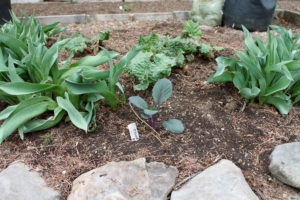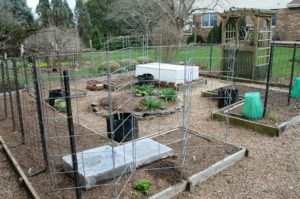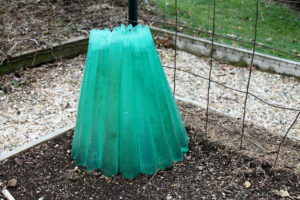The Vegetables Are In
April 11th, 2017
I’m not bragging or anything, but I thought I’d let you know that 90 percent of my vegetable garden is already planted.
I don’t mention this to make any of you “later bloomers” feel bad but to illustrate how many crops can – and really should – go into the ground before the threat of frost ends.
Based on historical averages, which, granted, don’t mean a lot anymore, most of the Harrisburg area sees its last killing frost around the third week of April.
That average often surprises gardeners because they’ve been taught to plant by the all-time latest killing frost date and not just the average last one.
The official all-time-late spring killing frost for Harrisburg is May 11, which is why most gardeners wait until then to plant mainstream veggies like tomatoes, peppers and beans as well as most annual flowers.
Those in more northerly and outlying areas wait even longer since they’ve had frosts late into May already.
Waiting until the coast is historically clear of frost isn’t a bad idea when you’re talking tender plants that will die in a frost. Even losing your tomatoes some years after planting early can be enough to make the risk not worth taking.
But the kicker is that a wide range of vegetables not only tolerate frost, they prefer growing in cold weather and will do poorly in summer heat if you wait until after Mother’s Day to plant them.
That’s why I always plant in phases – starting with freeze-tolerant peas and onions as early as mid-March, adding other tough stuff in early April, then finishing off with the tender crops after Mother’s Day.
I can get away with early planting because I grow in raised beds, which dry out and warm up earlier than ground-level vegetable gardens.
I also employ some weather-protecting strategies, such as floating row covers, homemade plastic-covered boxes, and Wall ‘o Waters.
Floating row cover is a light-weight polyester material that’s porous enough to let in rain and adequate light. It traps enough heat to keep the inside a few degrees warmer while protecting tender transplants from cold winds that are still possible on April nights.
The other benefit of floating row cover is that it keeps cabbageworm moths from laying eggs on the cole crops, which means none of those annoying green worms inside the broccoli heads.
I made a frame out of old plastic PVC piping and drape floating row cover over it to make a sort of fabric mini-greenhouse.
My cabbage and broccoli are happily growing under it after going in the last Saturday of March. I grow my own seedlings inside under basement lighting so I’ll have plants when I want them.
Here’s my system for starting seeds inside.
I also use a few lower, 2-by-2-foot boxes made out of 2×4 or 2×6 lumber with plastic sheeting stapled over them. I use these to warm up soil before planting seeds or young transplants and/or to keep a block warmer after planting with seeds.
I have a few in place now that are helping to germinate and grow blocks of spinach and mixed greens that I direct-seeded the first week of April.
Wall o’ Waters are teepees made out of plastic cylinders that get filled with water. The water traps heat during the day and keeps temperatures above freezing inside, even when air temperatures dip into the low 20s.
I always set out two of them in late March to begin warming the soil. Then at the beginning of April, I plant two early-maturing tomato plants inside each that I started in early February in the basement. You’ll have to start your own to have tomatoes that early since garden centers wait until later in spring to bring in theirs.
Protected by Wall o’ Waters, I’ve never lost an early-April tomato in more than 30 years of doing this. Don’t expect to get ripe tomatoes 6 weeks early (the cold soil still slows these heat-lovers), but if you use an early variety and this protected early timing, you’ll usually have fresh, ripe tomatoes by the end of June.
Cherry tomatoes and ‘Early Girl’ are two of the best bets for hurrying the arrival of garden-fresh tomatoes – which in my world is the No. 1 reason to garden.

My basement-grown purple cabbage is in the ground, flanked by some tulips and backdropped by an emerging rhubarb.
By the first week of April, I’d also planted a long block of potatoes, blocks of three kinds of radishes, a “par-cel” plant (a curious blend of celery and parsley that I found in a Lancaster County greenhouse), and seeds of lettuce, mesclun and kale.
The weekend after that, I added my transplants of cauliflower and leeks, seeds of carrots, beets and kohlrabi, and a second round of peas and lettuce.
The only space not planted is the trellising around the bed perimeters that will be home to my warmth-loving tomatoes, cucumbers, melons and pumpkins. A 6-foot PVC-pole teepee will go over the rhubarb plant in the center of the garden to grow pole beans in early May.
My peppers will go in the space vacated by the radishes in mid-May, and my hot peppers and eggplants will go in pots and fiber growing bags – also in mid-May.
Much of what I’ve planted in late March to early April will mature by late spring to early summer. That works so much better than planting later but then having spinach and lettuce bolt to seed or onions turn hot or kohlrabi turn woody if they aren’t yanked before the peak heat of summer.
As my early stuff comes out, I immediately replant the space with crops that are fine with summer heat and that will mature before fall frost, such as bush beans, collards, more cucumbers, more beets, and an occasional okra.
By later summer, I’m replacing harvests with more cold-tolerant stuff, such as kale and new rounds of radishes, lettuce, carrots and cole crops.
I milk a lot out of the space. It gives me good exercise in the fresh air and yields some of the best-tasting, most-nutritious and organically grown food. It’s cheaper than produce at the store, too. And it helps make me reach for a tomato instead of an Oreo…
See George’s list of best vegetable varieties.










